Indholdsfortegnelse
Plastisol blæk: hvorfor det er det bedste valg til serigrafi
Metabeskrivelse: Learn why plastisol ink is the top pick for bright, long-lasting prints on clothes, labels, and more. Compare it to other inks and see how to use it right.
Hvad er Plastisol-blæk?
Plastisol ink is a special ink used in screen printing. It is made from PVC harpiks og blødgørere. This mix makes it thick and sticky. People love it because it works great on fabrics like t-shirts, hats, and bags.
Did you know? Over 70% of screen printers use plastisol ink!

5 Big Reasons to Choose Plastisol Ink
1. Covers Dark Fabrics Perfectly
- Plastisol-blæk er uigennemsigtig (not see-through).
- It stays bright on black or dark-colored fabrics (like band t-shirts).
- Water-based inks can’t do this!
2. Lasts a Long Time
- Prints stay bright after many washes.
- Fantastisk til work clothes eller outdoor banners (resists sun and rain).
- Colorfastness means colors don’t fade.
3. Nem at bruge
- No need to pretreat fabrics (unlike water-based inks).
- Virker på cotton, polyester, and blends.
4. Fun Special Effects
- Tilføje glitter, puff, or metallic finishes.
- Bruge Rutland Magnaprint for 3D textures.
5. Great for Big Jobs
- Stays wet in screens longer (no drying during printing).
- Perfect for masseordrer (like school event shirts).
Plastisol vs. Other Inks: What’s Better?
| Blæktype | Bedst til | Not Good For |
|---|---|---|
| Plastisol | Dark fabrics, bulk jobs | Miljøvenlige projekter |
| Vandbaseret | Soft feel, eco-friendly | Dark fabrics, long washes |
| Udledning | Vintage-look på bomuld | Synthetic fabrics |
| Eco-Solvent | Syntetiske materialer | Low budgets, quick jobs |
Is Plastisol Ink Bad for the Earth?
Old plastisol inks had chemicals called phthalater (bad for the environment). Now, companies make safer options:
- Phthalate-free inks: Try Union Ink ECO Series eller Wilflex Epic.
- Low-VOC inks: Matsui og Grøn galakse are greener choices.
Se efter: Øko-Tex Standard 100 certification (means safe for skin).

How to Use Plastisol Ink: 4 Easy Steps
- Helbred det rigtigt
- Varm op til 300–330°F for 60–90 sekunder.
- Brug en M&R dryer for even heat.
- Pick the Right Screen
- Bruge 110-160 mesh for detaljer.
- Bruge 200+ mesh for thin inks.
- Add Special Mixes
- Soft-hand additive makes prints comfy.
- Silikone helps prints stretch.
- Avoid Mistakes
- Don’t add too much water (over-thinning).
- Test print first!
Where to Use Plastisol Ink
Tøj
- Gym shirts, hættetrøjer, og event tees (ligesom Gildan eller Hanes brands).
Reklameartikler
- Muleposer, silicone wristbands, og mousepads.
Industrielle anvendelser
- Car decals, PVC labels, og durable tags (meets ASTM D4366 standard).
Ofte stillede spørgsmål
Er plastisolblæk sikkert til babytøj?
Kun hvis det er phthalat-fri (check the label!).
Kan jeg printe på nylon?
No—plastisol doesn’t stick well to nylon or silk.
Will plastisol crack?
Only if you don’t cure it right! Follow heat guidelines.



